The official programme for the inaugural London Marathon in 1981 described Leslie Watson as “the Queen of the Roads”. Her prolific racing led to her becoming the public face of the women’s marathon in the UK. Watson had run over 40 marathons in six years. She had featured in many newspaper articles and given advice to road runners through talks and seminars. 1981 was one of the peak years of the marathon boom and was also a peak year for Watson. She ran 18 marathons, winning the Women’s Amateur Athletic Association National Marathon Championship and seven other marathons. Watson also set a 50-mile world best at a race in the USA. This post looks at how her running career developed prior to and during 1981.
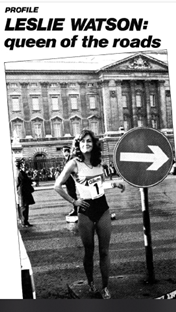
Leslie Watson’s early running career in Scotland
Leslie Mary Broadfoot Watson was born in Glasgow on 4th February 1945. She was the only daughter of a doctor and a dancer. Her name is sometimes written as “Lesley”, the more common spelling for women. In a newspaper interview in 1982, she explained that her father had made a mistake when registering the birth.
When she was ten, Watson joined Maryhill Harriers Ladies with a friend. She described herself as a “scrubber”, an athlete with little innate talent who made progress by training hard with her coach, John Anderson. She began to compete in cross country, finishing fifth in the Scottish National Championships in 1962. That race won by Dale Greig. In 1966, Watson won the Scottish Championships. She retained the title in 1967, narrowly beating Dale Greig in both races.
Even after Leslie Watson had switched her focus to the marathon, cross country remained an important part of her racing calendar. In an interview in Athletics Weekly in 1981, she chose a cross country race as her most pleasing performance. “Ninth in the English CC Championships at Bury in 1964 because it was the first time I’d every beaten anyone of any consequence.” The person of consequence may have been Georgena Buchanan, who was the Scottish Cross Country Champion at the time. Buchanan finished in 21st place.
Watson also competed on the track and became the Scottish mile champion in June 1966. She ran 5:14.4, finishing ahead of fellow Maryhill Ladies AC runner Catherine Kelly and Dale Greig. Watson described “never being able to break the Scottish mile record in the sixties” as her greatest disappointment.
The move to London
On leaving school, Leslie Watson qualified as a physiotherapist at the University of Glasgow. In 1970 she moved down to London for her work. She worked in the National Health Service for six months before leaving to set up a private practice.
She joined one of the top women’s clubs, London Olympiades AC and competed for them in cross country, track and road relays.
In the early 1970s, road races for women were few and far between in the UK. They mainly consisted of road relays with legs of around two miles. The Women’s Amateur Athletic Association’s competition rules prohibited race distances over 6000 metres (about 4 miles) and women were not allowed to race against men. (See my article Women’s Marathon Milestones – 1975 on Playing Pasts). There were no limits on the distances men were permitted to run. Many of the races popular in the post-war period, such as London to Brighton and the Edinburgh to Glasgow Relay, were still being held. (See Road Racing in the 1950s).
Permission for women to run the marathon
By 1975, both West Germany and the USA had changed their rules to officially permit women to run the marathon. The UK was lagging behind. Some British women travelled to the USA to compete in road races and others “crashed” men’s races, turning up and running without a number. The WAAA, the governing body for England and Wales, finally agreed at an Extraordinary General Meeting in April 1975 to arrange for “experimental rules” to be introduced. These rules permitted Senior women, aged 21 and over, to compete at the marathon distance. Younger women, aged 17 and over, could compete at a range of shorter distances in three age brackets.
The Masters and Maidens Marathon
In his history of the WAAA, Mel Watman records that the new rules came into force in October 1975. The first marathon event in which women could compete was the Masters and Maidens Marathon in Guildford on 19th October 1975. Masters and Maidens was not an official race – it did not have a permit from the Amateur Athletic Association. The organiser, Alan Blatchford, aimed to encourage women, children and men aged 40 plus to test themselves over the distance. Men under 40 who had run a marathon in under three hours were excluded and the time limit was five and a half hours. The youngest finishers were a 13-year-old girl and a 14-year-old boy. Twelve women completed the distance, including Leslie Watson.
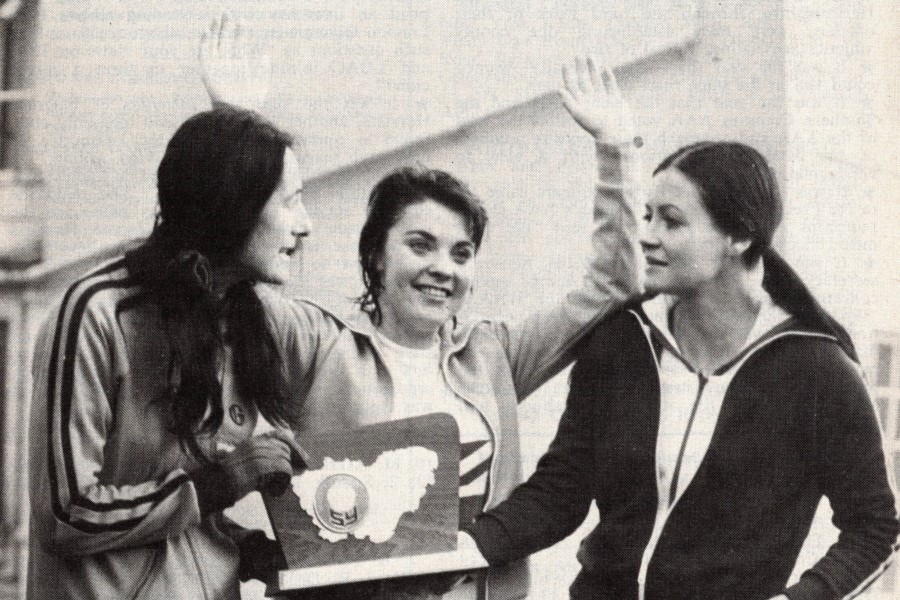
Hilary Matthews (centre), winner of the 1975 Barnsley Marathon, with Norma Campbell (2nd) & Leslie Watson (3rd). Athletics Weekly 27th December 1975. Photographer not credited.
Leslie Watson’s first marathon
Leslie Watson was inspired by Dale Greig and Bridget Cushen to think that the marathon might be her best distance. Both Greig and Cushen had broken the rules to run in men’s marathons. Greig had run the Isle of Wight Marathon in 1964 and Cushen had run the Harlow Marathon in 1973. (Watson had raced against both women over cross country courses.) Watson took the first opportunity there was for women to run the marathon distance, the Masters and Maidens Marathon.
I saw the Guildford marathon advertised. I did very little training just one 20 mile run from Kent into London. I went out the night before the race and had lots of bad red wine and then on the way down I was eating chocolate and popcorn. I felt sick by the time we started and I was exhausted after 3 miles.
Despite her poor preparation, Watson finished third in just over three and a half hours. Her marathon career was well and truly under way. In November that year, she competed in the hilly Barnsley Marathon, finishing third. She would return to, and win, both events the following year.
Watson topped the Scottish marathon rankings in 1976, ’77 and ’78, was second in 1979 and first again in 1980. In 1978 she ran under three hours for the first time, and this was the first of many sub-3 performances.
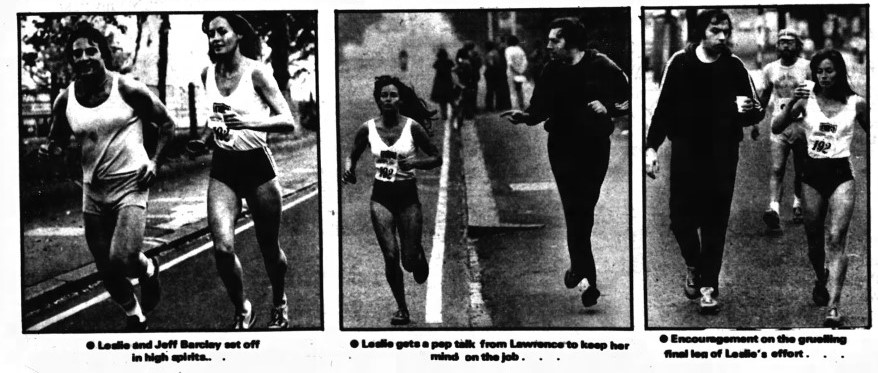
Leslie Watson running in the London to Brighton race with support from Lawrence Brampton, Shepherd’s Bush Gazette & Post, 4th October 1979
Leslie Watson – challenging male traditions at London to Brighton
After the rules changed in 1975, race organisers did not automatically open their races to women. In fact, most races continued to be men-only for a few years. One very well-known race which was slow to admit women was the London to Brighton ultramarathon. Dale Greig had run the race unofficially in 1972, starting an hour before the men. It had been organised since 1952 by the Road Runners Club (RRC), an organisation founded to promote men’s distance running in the UK.
By 1979, the RRC still hadn’t allowed women to enter their flagship race. Five women decided to enter London to Brighton unofficially to show that women were able to complete the 54-mile distance within the 8 hour 23 minutes time limit. They were Ruth Anderson of the USA, three British women, Leslie Watson, Lydia Kirk and Lyn Billington and another, unnamed woman. Leslie, Lydia and Ruth all finished well within the time limit, Leslie finishing first in 6 hours 55 minutes and 11 seconds, faster than most of the men. Lyn and the other woman dropped out.
In 1980, the RRC put on the first official women’s London to Brighton race with a trophy for the female winner.
Leslie Watson – “Queen of the Roads” in 1981
Leslie Watson began 1981 ranked equal fourth for the marathon in the UK by Athletics Weekly. She ran at least 20 marathons that year, winning nine of them. Seven of them were abroad: Essonne in France, Geneva in Switzterland, Enschede in the Netherlands, Berlin, New York, the Marine Corps Marathon in Washington, USA, and Sea of Gallilee in Israel.
In the inaugural London Marathon in March, which was won by Joyce Smith, Watson finished 11th in 2:48:05. In May, she won the WAAA National Marathon Championship at Rugby. Athletics Weekly reported that this was her 53rd marathon. Watson commented that her time was dreadful compared to Joyce Smith’s standard (Smith was not in the race). However, she had run a 50 mile road race in the USA the weekend before Rugby.
The list I’ve compiled of Leslie Watson’s races features eleven other road races in 1981, plus two ultras, six cross country races and two 3000m track races. I suspect that she ran more races than this as in her peak racing years she usually raced every week and often more than once a week.
Watson’s powers of recovery must have been remarkable as this set of races on four consecutive weekends in 1981 suggests:
Sunday 26th April – Cambridge Marathon for Veterans and Ladies – 1st – 2:47:30
Sunday 3rd May – Lake Waramaug 50 mile road race, Connecticut, USA – 1st – 6:02:47 – world best
Saturday 9th May – 3000m track race
Sunday 10th May – WAAA National Marathon Championship, Rugby – 1st – 2:49:08
Saturday 16th May – Isle of Wight Marathon – 1st – 2:52:56 – course record
Women’s marathon performances improved in 1981. Watson finished the year ranked tenth in the UK.
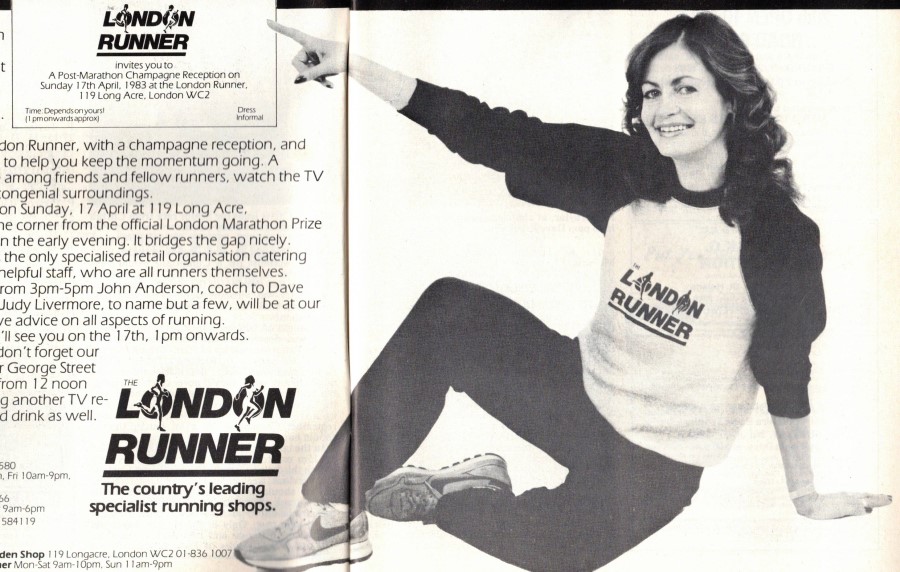
Part of an advertisement for The London Runner, promoting a post-London Marathon reception, 1983.
The London Runner shops
On 14th December 1981, in partnership with Lawrence Brampton, Watson opened a running shop, The London Runner, in George Street in the West End of London. It was Brampton’s idea. He was a former caterer who took up running in 1980 to lose weight and ran the 1981 London Marathon.
By 1983, there were three more London Runner stores in Covent Garden, Croydon and Reading. Watson frequently appeared in advertisements for the shops and hosted in-store runners’ clinics.
Sexism
Leslie Watson featured in many articles in the press. She appeared on the front cover of Athletics Weekly several times. She was probably the first female athlete to be on the cover of the RRC Newsletter (April 1979). Newspaper articles invariably referred to her appearance, calling her the “glamour girl of marathons” and “Britain’s pin-up of the sport”. Journalists often explicitly sexually objectified her. For example, Christopher Brasher opened his profile of her in The Observer in December 1980 with these words:
Leslie Watson is a beautiful woman with a magnificent shape which is famous throughout the world of long-distance running: famous because its beauty brings a smile to all men who run with her.
Social gender norms made it acceptable for Brasher to focus on a Watson’s looks as much as on her performance. It was only five years since women had been permitted to race long-distance and they were in a very small minority in road races. Male runners like Brasher may have felt uncomfortable with the idea of women with the endurance to run as many marathons as Watson had (47 since 1975). Women were no longer there to hold the coats and support the men, they were racing in their own right. What did this mean for male runners who had had road racing to themselves for most of the century? How could they make sense of a woman with superior powers of endurance to themselves? Brasher refers to this, saying “Is it any wonder…that we men…regard her with awe and with love?” By framing Watson as the object of the male gaze, there for the enjoyment of men, Brasher is diminishing her agency and putting her in her social place.
206 marathons
These days elite athletes tend to target one or two marathons a year. Leslie Watson often ran them on consecutive weekends and sometimes even on consecutive days. In her twenty-year marathon career, she was reported to have run 206 marathons and won more than 60 of them.
Watson’s last marathon was the Isle of Wight Marathon in 1994 which she won for the seventh time. After that she developed a knee problem which prevented her from running. In 1997, Watson told The Herald:
”I ran my last marathon three years ago, on the Isle of Wight. I’ve a twisted nerve in my knee, and running is now impossible.” As a physiotherapist based in London, operating her own flourishing practice near Harley Street, she does not delude herself there will be any return.
In Athletics Weekly in 1981, Watson said she intended to continue competing indefinitely: “can’t ever imagine not competing; I wouldn’t like to coach or officiate.” Whilst this was not be, she found another sport to compete in, taking up powerlifting in the 1990s. She has competed in national, European and world championships. Her most recent competition was in March 2022.
Watson is honoured each year by her first club, Maryhill Harriers. They award the Leslie Watson Trophy to their Women’s Merit League Champion. And Watson has a place in the history of the club, which acknowledges her as “one of Scotland’s top marathon runners of all time”.
Leslie Watson died on 1st January 2024, aged 78.
Sources
Banner photograph: from an advertisement for The London Runner, promoting a new Gore-tex waterproof training suit, 1983
Profile of Leslie Watson, Scottish Distance Running History website, September 2015
Scotland’s People Register of Births. When I wrote this article in December 2022 I recorded Leslie Watson’s date of birth as 4th February 1948. This was the date of birth given in her “Who’s Who” profile in Athletics Weekly in 1981. Numerous newspaper articles gave an age consistent with a 1948 birth, including several of those listed below. Following Leslie Watson’s death on 1st January 2024, Arnold Black, Scottish Athletics official historian, pointed out that Leslie Watson’s date of birth was most likely to be the 1945 entry in the Register of Births as this would fit with the age categories she competed in as a girl. I amended the article. The 1945 date of birth was subsequently confirmed by Leslie Watson’s relatives.
“A lovely way to travel”, Christopher Brasher, The Observer, 14th December 1980 – the full text is available on the Scottish Distance Running History website
“Leslie’s Streets Ahead”, Sue Hercombe, The Journal (Newcastle), 13th December 1982
Maryhill Harriers’ club history. Maryhill Harriers Ladies became Maryhill Ladies Athletic Club in 1961 and Leslie Watson moved to the new club.
Scottish Track and Field Rankings 1959-2000 and SWAAA Championship results, the Scottish Association of Track Statisticians (SATS)
SWAAA Executive Committee minutes 23rd March 1962
“Who’s Who In British Athletics – Leslie Watson”, Athletics Weekly, 13th June 1981
“Women are No Strangers to the Marathon”, Cliff Temple, Athletics Weekly, 3rd February 1973
“The Official History of the WAAA – 1922-2012”, Mel Watman, SportsBooks Limited, Cheltenham, 2012
Milestones in Women’s Marathon History – 1975 – Permission for women to run the marathon in the UK, Katie Holmes, Playing Pasts website
British Women’s Merit Rankings, Athletics Weekly, 31st January 1981
“London to Brighton”, Bill Brown, Road Runners Club Newsletter, January 1980
“The long-distance menace elbows into town”, William Hickey, Daily Express, 15th December 1981
206 marathons – this was the total that Leslie Watson stated. I am compiling a list of her races using data from a variety of sources. So far I have confirmed 142 marathons and 65 wins. Thank you to Mick McGeoch for filling in some of the gaps in my list.
“The iron lady is still on her mettle”, The (Glasgow) Herald, 8th November 1997
“The pill-popping physiotherapist”, Jean Donald, The Herald, 8th June 1989
Westminster and Pimlico News, 9th July 1982
Leslie Watson’s profile on the Open Powerlifting website
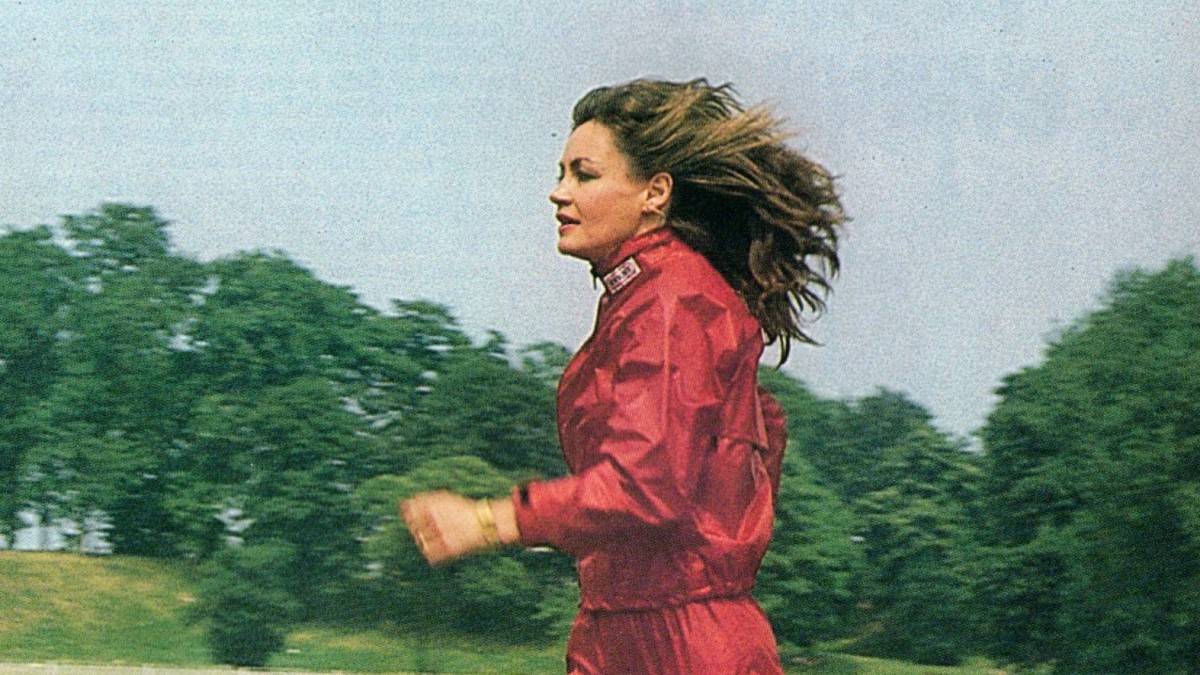

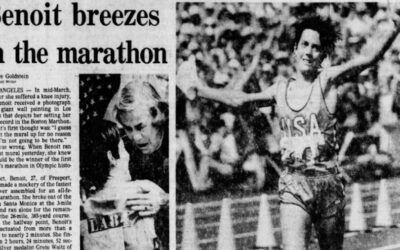
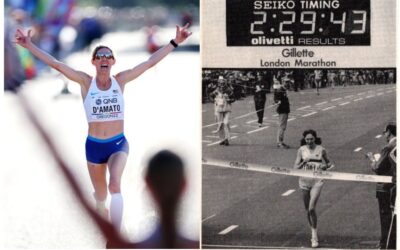
This is a truly fantastic story. What an amazing athlete. It’s quite embarrassing reading, once again, about the neanderthal male attitude towards females. Her record of achievement is awesome indeed, something to be extremely proud of.
Thank you for commenting Baz. I agree that Leslie Watson’s achievements were outstanding – I think they should be better known. Katie
I ran a chunk of the 1981 London marathon with Leslie, and she was great company! I must’ve left her at some point as I ended up doing 2:36 but I remain privileged to have run in her presence for a tiny period of time!
Thank you for sharing that story Paul. When I’ve posted about Leslie Watson on social media, other runners have always had only positive things to say about her which is really nice. I imagine that running the first London Marathon is a special memory for you. Katie
Met her a couple of times , was a lovely lady.
Everyone seems to say nice things about Leslie Watson. I think she was very well liked. I wish I had met her.
Katie
Hi Katie, you have written a lovely article. You do indeed have the correct age for Leslie (04/02/1945)
She is greatly missed by her many special friends, partner of 30 years Budgie, and all Budgie’s family who welcomed her into their lives since 1995. She has left a hole that will never be filled.
Hello Mandy, thank you very much for your kind words and for confirming Leslie’s date of birth. Please accept my condolences on your loss. Whenever I’ve shared Leslie’s running achievements on social media over the past few years, dozens of people have commented. She seems to have been universally well-liked, both by those who knew her well and by those who only met her briefly. I am sorry that I never managed to meet Leslie. Her story forms an important part of the history of women’s distance running in the UK and I will continue to research and write about her.
Katie
Hi Katie,
I have only come across your article on Leslie, through the comments on my post on ‘I am…was a runner’ today.
Being Leslie’s closest friend of over 50 yrs, I can honestly say that she was one of these rare people that nobody had a bad word to say about her. She had time for everyone, always sympathetic to anyone that had an injury problem, would often advise what sort of running shoe someone should wear depending on their running style and more often than not, at the end of her race, would often jog back down the field cheering others on. A human being to be proud of. She is greatly missed.
Hello Lawrence, thank you very much for sharing your memories of Leslie. It is good to hear about how she helped and inspired many runners. Katie
A lovely friend. I trained with her every week for a number of years as well as going with her to train at La Santa on Lanzerote. It was a pleasure to know her.
Thank you for adding that memory Irene.Everyone comments on how well-liked Leslie was. Katie
Leslie was an individual, true inspiration and had a great sense of fun. She was responsible for my running career. We ran many miles over Hampstead Heath, Leslie would say we’d run 10 miles when in fact we’d end up running closer to 20.. She was a good friend, very generous and I shall miss her.
Thank you Mel for sharing this memory of Leslie. She was clearly much-loved by many friends and even people who only met her once comment on her warm and friendly personality. I wish I could have met her. Katie